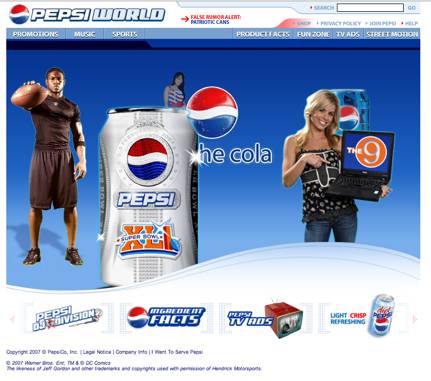Brand Websites are used by all manner of non-online product and service organizations to build brand preference for the organization’s offline products and services. Brand Websites exist to alert consumers to online and brick and mortar retailers where purchases can occur.
On Brand Websites, users get product or service information and the revenue model is to increase retail spending, similar to other non-direct response advertising.
Brand websites, while not transaction based, are still essential for any company hoping to establish credibility and preference with its customers. A B2B and a B2C brand website are profiled in this section.

Business Goals: Brand Websites are used by all manner of non-online product and service organizations to build brand preference for the organization’s products and services. Brand Websites exist to alert consumers to online and brick and mortar retailers where purchases can occur.
User Goals: Get product or service information
Revenue Model: Increase retail spending similar to other non-direct response advertising
Content: Usually publisher-generated, but may also be a joint venture with media organizations who drive traffic and provide website content.
Navigation: Often starts with a geographic filter and then moves to product or service navigation based on user-oriented categories. May also be interactive and include games, contests and sweepstakes that increase user involvement and time spent.
In this day and age, a company without a website will become invisible to its customers. You might say that it’s akin to not having a telephone! So brand websites, while not transaction based, are still essential for any company hoping to establish credibility and preference with its customers. Pepsi and Boeing are profiled in this section.
[text_ad]
Pepsi World
Website Continues to Keep Pepsi Ahead of Coke
The first question everyone asks: “Why would anyone go to Pepsi.com?” This is because we mostly think of the Web as a distribution vehicle. We think of ordering books at Amazon, or reading content at CNN, or downloading music from iTunes. How do you drink a soda on a computer screen?
So, who goes to Pepsi.com? Load up the fun, entertainment-packed Pepsi.com and it’s obvious in a glance. The site is clearly designed to attract and entertain teens and young adults, the current target demographic for Pepsi. The strategy works, Pepsi.com ranked #4 by visits in the Food and Beverage Brand category, (Coca-cola.com ranked #14) by Hitwise. But if you can’t sell anything on your site, why devote the human resources, time and budget to create it? In other words, what’s the payback?

With traffic ranging from 96,000 to 312,000 unique U.S. visitors during 2006 (Compete), the website continues to keep Pepsi ahead of Coke. The site has just 491 pages of content that have drawn an impressive 71, 276 inbound links.
Boeing
High-End B2B Example of a Brand Website
The Boeing Brand Archetype Website is a robust example of a high-end B2B website. The site is organized by products and services. A special password protected section is available to the media. The site includes text, photos and video.
With unique U.S. visitors ranging from 319,000 to 381,000 during 2006, the Boeing website includes almost 50,000 pages of content and more than 166,000 inbound links.

This article was written by Don Nicholas with the help of Peter A. Schaible. It is only one part of a series on Internet Business Models. See below for the rest of this series:


